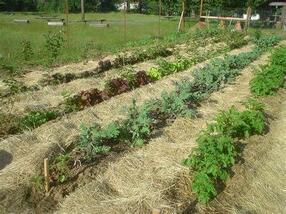CONSERVATION CORNER
A weekly blog for all things conservation
 By: Kevin Brown, Ag Team Leader So, in part one I outlined how easy things are to garden this way. I would like to explain a few reasons why in this article. The comment I finished with last week was that most people plant too early. Now, if you are having great luck with your garden, then don’t change anything. However, if you aren’t, this could be one reason. I looked up planting times for our area for different things and they were way later than what I have seen people plant at. I tried to plant early one year, and by early, I mean like May 20 or so. That is not that early.
The plants struggled for weeks and I even lost a number of them. Then one day, almost like flipping a switch, they decided it was time to grow and they took off like nothing was wrong. I figured out the disease was a bacterial wilt of some sort. I was concerned that it was something that was an issue with no till gardening and not with other ways of doing things. Nope, a lot of people gardening the “normal” way were having the same problem. I was talking with a counterpart of mine who was not having the issue, and I was asking her questions to see what the difference was. She said she planted late that year. Bam. That was the answer. This year I was back to planting around June 15th, and I will never do it earlier. The garden was a success this year again. Some people really question the whole weed thing, and especially why weedy hay won’t give you weeds in the garden. Well, here’s why. Seeds need a couple things to germinate. Water, soil, and sun. The basis of life. If you take one of those things away, you can’t have germination. So, if you pile on hay 12” thick in the fall, and it becomes 6” thick that next spring, weeds can’t germinate. If they are high enough in the hay to get sunlight, then they are too high for good water and any soil-to-seed contact. If they are low enough for good soil-to-seed contact, then they are too deep to get sunlight. They just can’t germinate. If you have weeds, it is because the hay (mulch) is not heavy enough. Watering is another one. Lay a thick coating of hay on the ground anywhere and then go check under it during a drought. What do you find? Wet ground. This is for a couple of reasons. 1- the hay is a calling card for all living things in the soil. They come to live in the soil around this hay. They create channels and such for water to infiltrate the ground. When you get rain, it actually enters the ground. By rototilling the ground, you destroy the structure. Then, when you get the first rain on it, it seals the top off and very little rain can actually enter the ground. And 2- the hay prevents sun from beating down on bare soil and not only drying it out but making it extremely hot. Most plants (and soil biology) do not like hot, dry soil; but they love it under the hay. This keeps it wet all year. Rocks are an easy one, right? If you don’t rototill them up, they never show up. No rock picking. These are all the reasons that make me want to garden, but the side benefit is that it is also the best way to do things for the environment. More soil microbes, less soil erosion, less nutrients lost, less water runoff, less chemicals used (none), less fertilizer used (none), etc. It all sounds good to me.
0 Comments
Leave a Reply. |
AuthorsVarious staff at the Bradford County Conservation District Archives
July 2024
Categories
All
|
|
Bradford County Conservation District
Stoll Natural Resource Center 200 Lake Road, Suite E | Towanda PA 18848 Phone: (570)-485-3144 |
